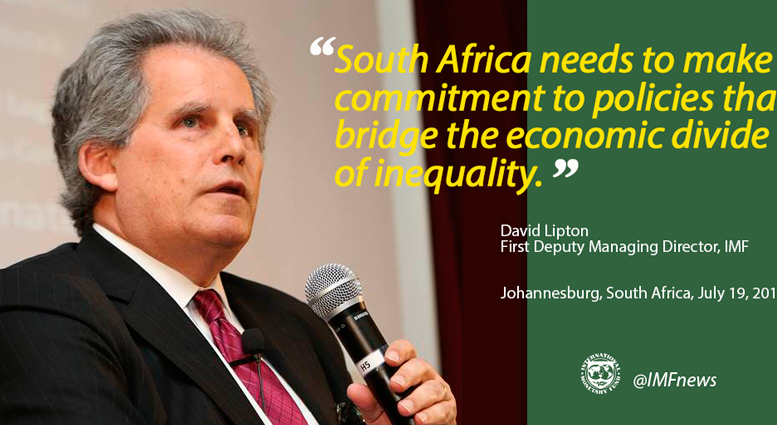Country economies are linked to one another through trade and international financial flows. On both fronts, South Africa faces difficult conditions.
Trade
Low global growth, reflected in low commodity prices, limits the value of South Africa’s exports. In particular, a shock from China will significantly exceed the impact of shocks from the United States and European Union, to the extent that a one per cent drop in China’s growth will mean an equal drop in South Africa’s growth after one quarter. And, while the prospects for China’s growth have a degree of inscrutability[1], low commodity prices are certain to hit sub-Saharan Africa, now the destination of 30 per cent of South Africa’s exports. Lower oil prices relieve pressure on the balance of trade, but oil prices have been volatile over the past year.
Export promotion is vital, but it is subject to partially irreversible fixed costs associated with entering new markets. Moreover, the IMF finds that economic policy uncertainty has a statistically significant impact on the level of exports and the sensitivity of exports to movements in the real effective exchange rate (REER). The IMF has developed a ‘news chatter’ measure of economic policy uncertainty which outperforms the REER in explaining exports. This measure deteriorated in 2011-2012 and again in 2014, though it has picked up somewhat in 2016.
Financial flows
The flip side of trade balances is financial flows necessary to accommodate them. And here there are several things to be said:
1. Almost half of South Africa’s portfolio liabilities are held by US investors and the IMF cites a study which estimates that a one per cent rise in US interest rates will result in a rise of 0.73% in South Africa’s long term rates, with no effect on short-term rates. More generally, a 1% increase in US bond yields would spill over to bond yields in emerging markets, result in capital outflows and lower industrial output growth by 3.5% after a year. Most emerging markets would also experience significant exchange rate depreciation.
2. In recent years, external financing has shifted from foreign direct investment and portfolio investment towards short-term bank flows. Bank’s liabilities, though accounting for only a quarter of total investment, make up half of the liabilities due within one year. Moreover, European banks account for 76 per cent of total external bank borrowing, and these banks are retrenching at a high rate.
3. While South Africa’s credit spreads (a measure of risk of default) now trade in line with non-investment grade countries, ratings downgrades would have further effects on them. The impact on the sovereign would be limited by the low level of government debt denominated in foreign countries, but the impact on state-owned enterprises would be more severe. A non-investment grade rating would also weaken the profile of the foreign investor base, making South Africa more dependent on short-term investors, resulting in more volatile portfolio flows.
4. Reserve coverage is between four and fifteen per cent lower than the level indicated by the IMF’s reserve adequacy measure, and it is below the level in most emerging markets. However, technical measures can improve the situation. South Africa is urged to seize opportunities for increasing reserves.
5. It follows that South Africa is at risk of sharp economic adjustments should there be a sudden decline in net capital inflows. Currency depreciation and declines in bond and equity prices would be immediate. Growth could weaken sharply, as exports respond slowly to depreciation, while imports would drop. The fiscal deficit would rise, with exhausted fiscal space inhibiting a counter-cyclical response, and monetary policy would have to tighten. Banks would be forced to deleverage, at a time when firms face tougher external and bond financing, and non-performing loans would rise, reducing bank profitability and corporate tax due.
6. South Africa’s external debt was 41.3% of GDP in 2014 and 39.4% in 2015. It is expected to rise to over 50% in 2016, as a result of the depreciation of the rand in late 2015, and is expected to be 52.5% in 2021. However, a further 30% depreciation of the rand would push the external debt to GDP ratio above 60%. Other shocks – a widening of the trade deficit, lower growth and increase in the interest rate on public debt – will have moderate impact on the ratio.
7. A capital outflow shock would prompt adjustment in the portfolios of foreign investors and domestic non-bank financial institutions, reducing wholesale funding for banks. Higher funding costs, deteriorating asset quality and reduced liquidity would lead to lower financial sector profitability, leading to a liquidity squeeze, lower lending and reduced growth. The fiscal implications would be substantial, since finance, real estate and business services account for about a half of personal income tax and a third of corporate tax.
8. There would be no alternative to allowing the currency to depreciate to a new level set by the global market, and coping with the consequences through monetary and fiscal policy.
Conclusion
Our vulnerability to crises in our economic relations with the rest of the world has its origins in low savings rates and the consequent need for high capital inflows and high balance of trade deficits. The next crisis, if it comes, may originate from a trade shock, but is more likely to have a financial shock as its immediate cause. In either case, very low positive growth will turn negative.
Charles Simkins
Head of Research
charles@hsf.org.za
[1] The IMF projects China’s growth at 6.5% in 2016, 6.2% in 2017 and 6% in the following three years
http://hsf.org.za/resource-centre/hsf-briefs/the-international-monetary-fund2019s-2016-south-africa-consultation-report-what-it-says-ii-south-africa-and-the-global-economy

